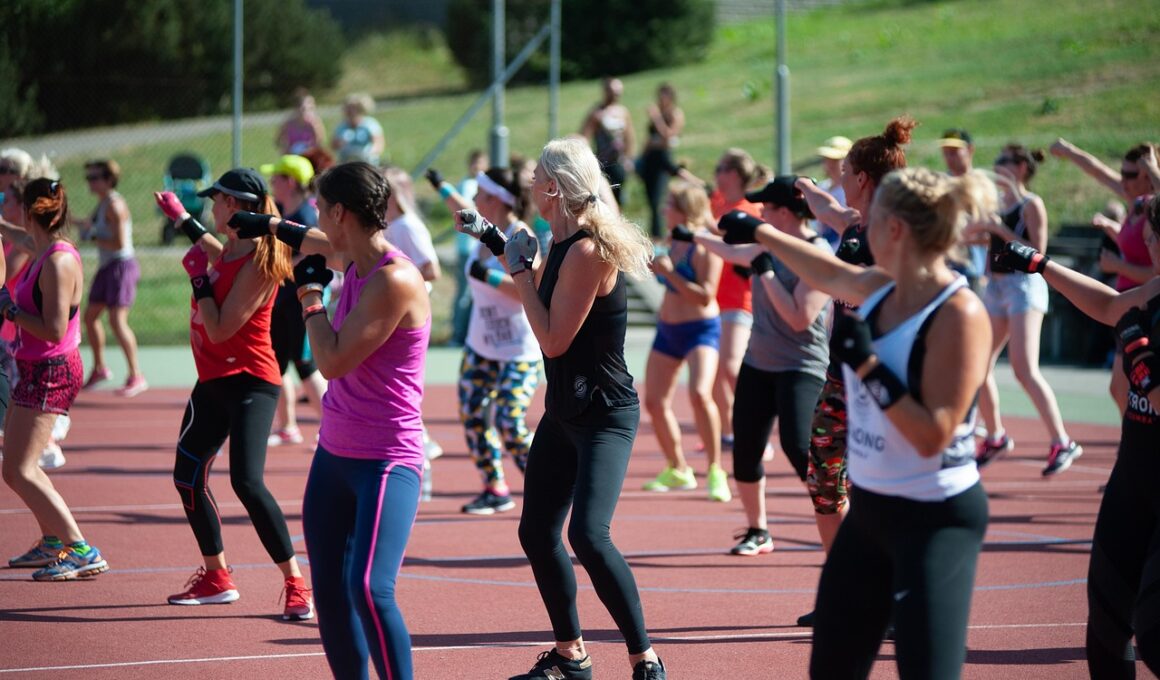Using Dance Cardio to Boost Your Athletic Performance
Dance cardio workouts have emerged as powerful tools for athletes seeking to enhance their performance on the field or track. Unlike standard cardio exercises that may feel monotonous, dance cardio combines movement with rhythm, making it not only effective but also enjoyable. This fusion of exercise and fun can lead to improved motivation and adherence to a fitness routine. Integrating dance cardio into your training regimen can boost endurance, stamina, and agility, which are critical components of athletic performance. Additionally, engaging in these workouts can help improve coordination and balance, skills that are essential for various sports. Dance cardio routines often provide a full-body workout, further increasing caloric burn and promoting cardiovascular health. With many styles available, from hip hop to Zumba, athletes can choose what resonates most with them, making workouts adaptable to individual preferences. Furthermore, dance cardio supports mental well-being, reducing stress levels and enhancing focus. This aspect can be crucial for athletes looking to perform under pressure in competitive situations. Overall, dance cardio is a dynamic approach to maximizing athletic potential through enjoyable and effective fitness routines.
One of the remarkable benefits of dance cardio is its ability to improve aerobic capacity. The high-energy movements experienced during dance routines elevate the heart rate significantly, thereby promoting cardiovascular endurance. This enhanced aerobic capacity translates into better performance in sports that require sustained energy output. Studies have shown that athletes incorporating dance cardio can experience an increase in VO2 max levels, indicating improved efficiency of oxygen utilization during intense physical activity. Moreover, while primarily known for its aerobic benefits, dance cardio also strengthens various muscle groups, including the core, legs, and arms. This muscle engagement is critical for athletes, as it fosters overall strength and power. The diverse movements challenge the body in unique ways, preventing plateauing effects typical of repetitive workouts. Additionally, dance cardio allows athletes to develop quickness, adaptability, and lateral movement, which are crucial in sports. The combination of rhythm and choreography fosters neural connection improvements, enhancing motor skills vital for any athlete. By participating in structured dance cardio sessions, athletes can achieve a finely tuned body that responds efficiently and effectively during competitions, contributing to overall success.
Incorporating Dance Cardio into Training
Integrating dance cardio into an athlete’s training schedule doesn’t have to be complicated. Athletes can start by allocating specific days during the week for these workouts, perhaps two to three sessions, complementing their regular training. Dance cardio can effectively serve as a cross-training choice, offering variety while allowing the body to recover from high-intensity sports-specific workouts. Furthermore, it provides an excellent opportunity for athletes to engage in active recovery, using rhythmic movements to loosen tight muscles while spending time on cardiovascular fitness. Importantly, training should remain aligned with competition schedules, ensuring that dance cardio does not replace crucial skills-based practices. Athletes should consider varying their dance styles to keep the routine fresh, mixing Zumba, jazzercise, or even ballet-inspired workouts. The incorporation of high-intensity intervals enhances effectiveness, as it challenges both endurance and strength. Athletes can also choose to join local dance classes or online sessions, incorporating a social aspect into their workouts. Ultimately, making dance cardio a fun commitment enhances overall engagement and satisfaction, leading to a more fulfilling fitness journey.
A major aspect of dance cardio that often attracts athletes is its adaptability to varying skill levels and fitness backgrounds. Whether you are an absolute beginner or a seasoned fitness enthusiast, there are dance routines tailored to your preferences and abilities. Utilizing beginner-friendly options allows athletes to ease into dance cardio progressively while still gaining the essential benefits. As competency and confidence grow, athletes can challenge themselves with advanced routines that push their limits. Accessibility is another crucial factor, as several resources exist online, enabling athletes to join classes or follow workouts from the comfort of home. This convenience makes it easier to maintain consistency without the need for expensive gym memberships or long travel times. Attributes such as spatial awareness and rhythm are improved through practice, leading to faster reactions during competitive events. Additionally, with dance cardio’s unique blend of exercise and creativity, athletes develop a greater appreciation for movement, enhancing their overall athletic experience. Thus, finding the right dance cardio program can significantly contribute to an athlete’s fitness and performance journey, empowering them to perform at their best.
Social Aspects of Dance Cardio
The social component of dance cardio is another valuable aspect that can influence an athlete’s experience positively. Engaging in group dance classes cultivates a sense of camaraderie and motivation among participants. This shared energy can often lead to better workout intensity, as athletes push each other to remain energetic and committed throughout the session. Many individuals find that the supportive environment of group fitness fosters accountability, which can ultimately lead to consistency and success. Moreover, participating in shared experiences creates opportunities to meet like-minded individuals, expanding social circles, and providing potential workout partners. This sense of community can be particularly beneficial for athletes aiming to stay committed to their fitness goals. Additionally, group classes often feature a wide variety of routines, accommodating different musical tastes and learning styles. This variety means athletes are less likely to become bored or oversaturated with similar movements week after week. Thus, by embracing the social aspects of dance cardio, athletes may find enhanced motivation, enjoyment, and ultimately, improved performance on and off the field.
For those skeptical about dance cardio’s application, it’s important to acknowledge how enjoyable physical activity becomes when it combines dance, music, and movement. This enjoyment factor has a profound impact on adherence to workout regimes, making it less likely for athletes to skip sessions or lose interest. The incorporation of favorite tunes and danceable beats brings a celebratory atmosphere to exercising. Athletes often report feeling more energized and uplifted after participating in dance cardio sessions compared to traditional workouts. Additionally, the vibrant settings of dance classes, often marked by colorful lighting and an upbeat ambiance, create a motivating environment. These factors culminate in an experience that not only transforms the body but positively impacts mental health. Engaging in exercise that’s perceived as fun can lead to more significant and sustainable changes in fitness levels. For athletes, embracing such invigorating formats can contribute significantly to their long-term success, making even challenging training phases feel more manageable. Therefore, blending dance cardio into an athlete’s regimen creates space for joy, fulfillment, and improved performance.
Conclusion and Takeaways
In conclusion, dance cardio offers myriad benefits that athletes can leverage to enhance their overall performance. From improved cardiovascular fitness and strength to refined motor skills and social engagement, this versatile workout modality fits seamlessly into any training program. As highlighted throughout this discussion, finding joy in exercise is key to long-term commitment, and dance cardio delivers that joy brilliantly. By adding dance cardio to their routine, athletes can break the monotony of traditional workouts and elevate both their physical and mental health. Additionally, recognizing how these sessions contribute to improved agility, endurance, and strength can motivate athletes to integrate them into their training. With myriad styles and adaptable options available, athletes have the freedom to create fulfilling, engaging routines that invigorate their fitness journey. Adopting a mindset of exploration and fun can lead to incredible results, both on the field and off. Ultimately, embracing the rhythm of dance cardio may not only amplify athletic performance but also enrich one’s lifestyle, fostering an active and enjoyable way to achieve fitness goals.
By understanding the dynamic, enjoyable nature of dance cardio, athletes can fuel their passion while focusing on their physical development. The myriad benefits offered by these workouts provide athletes a unique avenue for expression and fitness growth. As awareness of these advantages grows, more athletes will undoubtedly incorporate dance cardio into their training, reaping rewards that extend beyond the gym. Let’s dance and unleash our athletic potential while having a great time.


